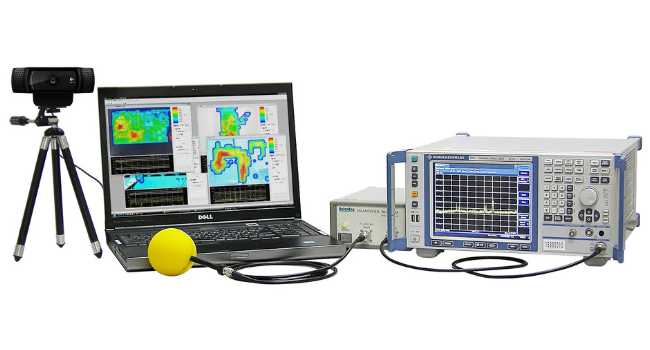Spectrum analysers can be used to observe modulated signals. But, some settings may have to be adjusted to observe the signals clearly.
In this example, we are going to show how the sweep time and selected detector type can effect the displayed data.
Source: Rigol DG4062 60MHz Dual Channel Arbitrary waveform generator.
Signal: Sine wave, linear sweep from 230KHz – 270KHz, Sweep frequency of 120Hz (~8ms period)
From the factory preset default mode, many spectrum analysers such as the Rigol DSA815-TG select an automatic sweep time which is determined by the frequency span and the RBW setting. In this example, we set the DSA to sweep from 150KHz to 600KHz at an RBW of 10KHz. The sweep rate default value for these parameters is 10ms.
In addition, the DSA815-TG collects 601 frequency “bins” per sweep. This means that the data in each bin is collected at a rate of 16us/point (10ms/601 points).
In this experiment, note that the modulation period (1/120Hz = 8ms) is much lower than the sweep rate (10ms) of the instrument.
When the sweep time is faster than the modulation, the data collected per sweep may not accurately represent the total span of the modulation. You can use the “Peak Hold” feature that will display the maximum values for successive scans and hold them on the display.
The figure below is a Peak Hold Scan for the experimental modulated signal described above.
You can see that the sweep time is 10mS.
Also note that the Yellow scan was collected using a Peak detector and the Pink was collected using an RMS Voltage detector.
How can the Peak and RMS Voltage detectors give the same trace?
The scan rate is too fast. This results in very small data sets at each frequency bin and can cause the data collected with different detectors to appear very similar.
Now, let’s change the sweep rate and observe the differences.
Here is the same input signal with the sweep time set to 1.5s (Peak Hold Disabled/Trace Clear Write selected):
You can now see that there are some differences in the Positive Peak Data (Yellow) and the RMS Average Voltage (Pink). This includes some of the modulation peaks and a different noise floor.
Here is the same input signal with the sweep time set to 5s (Peak Hold Disabled/Trace Clear Write selected):
Now you can observe quite different traces that more accurately represent the modulated data.
Here is the same input signal with the sweep rate set to 10s (Peak Hold Disabled/Trace Clear Write selected):
Conclusions: When observing modulated or pulsed signals, you can use the Peak Hold feature to “build” a trace from successive scans.
You can also gain more visibility into the signal type by changing the detector, but keep in mind that this may require lengthing the sweep time. This will allow the instrument to collect enough data at each frequency value to make more meaningful measurements.
Home / Knowledge Base / Knowledge Base Spectrum Analysers / Knowledge Base DSA800 Series / How can sweep time effect my Spectrum Measurements?
How can sweep time effect my Spectrum Measurements?
Posted on: December 16th, 2020 by Doug Lovell
Product Categories
AC Power Supplies / Frequency ConvertersDC Power Supplies
DC Electronic Loads
Test & Measurement
Safety Testers
EMC
Soldering Irons / Test Tools
Manufacturers
Rental

Service & Support
AboutContact
Newsletter
Service Returns Form
Returns Policy
Terms and Conditions
Privacy Policy
Shipping & Delivery
My account


Copyright © 2024. All rights reserved by Telonic Instruments Ltd
Website operated by Jumping Giraffe Ltd. Jumping Giraffe Ltd is not responsible for content on external websites.

































































































 FREE SHIPPING £75+
FREE SHIPPING £75+
 CELEBRATING 50+ YEARS
CELEBRATING 50+ YEARS
 PRICE MATCH GUARANTEE
PRICE MATCH GUARANTEE

